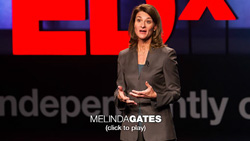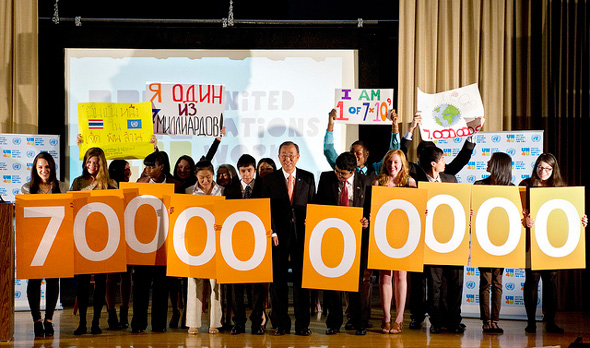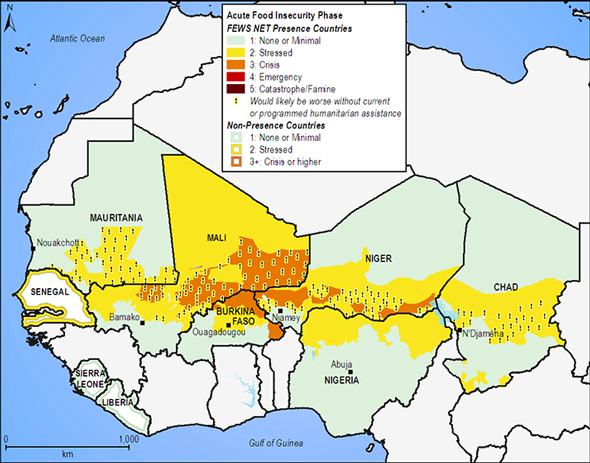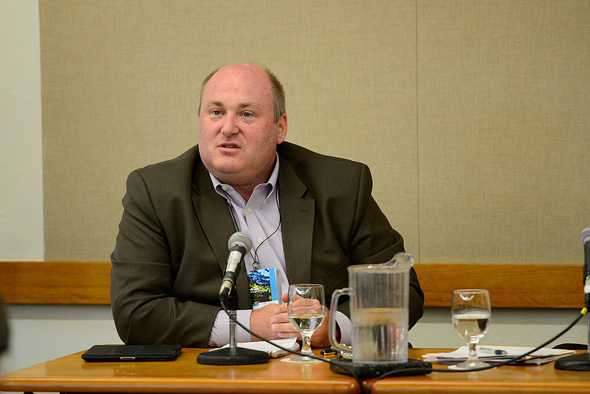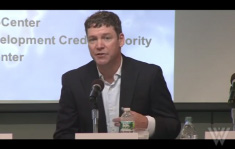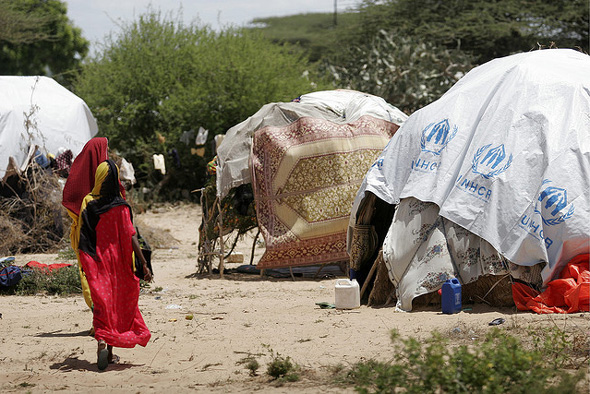-
Gates Foundation Spearheads London Summit on Family Planning
›July 12, 2012 // By Carolyn Lamere “Given the option, [women in developing countries] will have fewer children,” said Melinda Gates in a TEDxChange talk in April. “The question is: are we going to commit to helping them get what they want now? Or are we going to condemn them to some century-long struggle, as if this were still revolutionary France and the best method was still coitus interruptus?”
“Given the option, [women in developing countries] will have fewer children,” said Melinda Gates in a TEDxChange talk in April. “The question is: are we going to commit to helping them get what they want now? Or are we going to condemn them to some century-long struggle, as if this were still revolutionary France and the best method was still coitus interruptus?”
Wednesday, The Bill and Melinda Gates Foundation followed through on Gates’ pledge, helping to raise more than $2.6 billion at the London Summit on Family Planning as part of an ambitious goal of helping 120 million additional women in developing countries gain access to contraception by 2020. The summit was co-hosted by the UK Department for International Development and garnered support from other foundations and governments, including the United States, France, Germany, the Netherlands, South Korea, Norway, Sweden, and Australia.
To quote the Population Institute’s Robert Walker on Dot Earth, this is a big deal:Many of the challenges that we face (hunger, severe poverty, energy, food, carbon emissions) are seemingly intractable. Population growth, which is a challenge multiplier, is not intractable. Far from it. There are proven highly cost-effective means of lowering fertility rates: providing access to contraceptives, keeping girls in school, ending child marriage practices, and changing social norms (including attitudes toward women and desired family size) through entertainment media.
The focus on family planning for the Gates Foundation – one of the largest philanthropic organizations in the world – is relatively new (though their commitment to global health and development is not). Melinda Gates announced a commitment to maternal health in 2010, and the foundation first issued a family planning strategy in April of this year.
The move has been unwelcome by some, particularly some Catholic institutions who object to family planning. But Gates has been adamant that contraceptives “should be a completely non-controversial topic.” She argues that 90 percent of Americans find contraceptives “morally acceptable,” including herself and many other Catholics, so there is no reason for the taboo around international aid for family planning to continue.
“We’re not going to agree about everything, but that’s OK,” said Gates in a recent interview with CNN.
In the TEDxChange talk, which helped launch this year’s push, she credits her upbringing for instilling a strong sense of social justice. During her travels with the Gates Foundation, one woman from a slum in Nairobi told her, “I want to bring every good thing to this child before I have another.” That statement resonated with Gates: “We all want to bring every good thing to our children,” she said. “But what’s not universal is our ability to provide every good thing for our children.” Gates pointed to contraception as a way for families to plan for their future and manage their resources. She recognized the controversial history of family planning as population control, but argued that this new initiative is about providing choices to individuals, not imposing values.
Gates remains confident that as long as the foundation makes its mission clear, people will rally behind the cause.
“We’re not talking about abortion. We’re not talking about population control. What I’m talking about is giving women the power to save their own lives, to save their children’s lives, and to give their families the best possible future.”
Sources: BBC, The Bill and Melinda Gates Foundation, CNN, Catholic Family and Humans Rights Institute, Catholics For Choice, Dot Earth.
Video Credit: TEDxChange. -
World Population Day 2012: Looking Beyond Reproductive Health
›How should the seven billion or so of us on Earth mark World Population Day? Today, major global players are focusing on increasing access to family planning around the world. But there are other important aspects to population that also deserve our sustained attention.
The links between demography and development have come into the limelight over the last few months, first as advocates decried the last minute removal of reproductive rights language from the Rio+20 outcome document and now as the Bill and Melinda Gates Foundation prepares a massive funding push for reproductive health (starting today, not coincidentally).
“Multiple crises – food, fuel, and financial – have caused significant suffering and served as a wake-up call about the need to pay far more attention to the building blocks of sustainable development,” UN Secretary-General Ban Ki-moon says in an address for today. “Reproductive health is an indispensable part of the sustainable development equation.”
The sustainable development connection is fairly obvious. Environmental destruction in some of the most biodiversity-rich parts of the world has complex but significant population drivers, as Wilson Center consultant Laurie Mazur explains:Human impact on the environment is mediated by a host of factors, including culture, technology, institutions, and market forces. And inequitable socioeconomic systems mean that some human beings have far greater impact than others.
“Often, the value of biodiversity becomes apparent only when it is lost,” Mazur continues. “For example, with the global decline of honeybee populations, growers can now calculate the monetary value of pollination services that were once provided for free by nature. ‘Bee pollination is worth $190 billion,’ said Pavan Sukhdev, a Yale environmental economist, in an interview with Bloomberg. ‘But when did a bee ever send you an invoice?’”
But some generalizations can be made. We live on a planet dominated and transformed by human activity. As we have become more numerous, we have also become more adept at altering ecosystems for human use, replacing species-rich natural landscapes with simpler monocultures.
In other areas, population drivers threaten more basic scarcities: food and water, which in turn impede development and cost human lives. Some of the most successful efforts to address these relationships have combined women’s empowerment, family planning, and basic health interventions with site-based conservation and livelihood efforts.
But besides reproductive rights, there are other important aspects of population that deserve attention on this day.
The demographic dividend – a concept that marries population dynamics and development economics – requires more than just fertility decline to take effect in countries. Economic and social policies that prepare and enable young people to enter the workforce are just as important.
And the Arab Spring helps illustrate the complex relationship between population and democracy. “Among the five countries where revolt took root, those with the earliest success in ousting autocratic leaders also had the most mature age structures and the least youthful populations,” writes Wilson Center consultant and demographer Elizabeth Leahy Madsen. The work of fellow Wilson Center consulting demographer Richard Cincotta shows that countries with very young age structures are prone both to higher incidence of civil conflict and undemocratic governance. What happens next in Egypt, Libya, Yemen, and Syria will further test the connection between youth and democracy.
In South Asia, Madsen finds that as Afghanistan and Pakistan’s political circumstances have become more entwined, their demographic paths are more closely parallel than expected. “For Afghanistan, given its myriad socioeconomic, political, cultural, and geographic challenges, this is good news. But for Pakistan, where efforts to meet family planning needs have fallen short of capacity, it is not,” she writes in the first issue of the newly re-launched ECSP Report, “Afghanistan, Against the Odds: A Demographic Surprise.”
In more developed countries, population aging is a concern. At the Wilson Center last year, economists Andrew Mason and Ronald Lee explained the challenges that those on the other side of the “demographic divide” will face in the near future. From 2010 to 2015, 85 countries are projected to witness the largest absolute increase in history of their populations aged 60 and over, straining public welfare systems and reducing labor forces. It’s not the “catastrophe” that it has been portrayed to be in the media, they said, but like many demographic issues, it is a challenge that will require planning for.
These connections demonstrate the wide importance of population dynamics to understanding how the world works today. Demography is the study of us – all seven billion of us. Demography affects – and is affected by – economics, political stability, health, the environment, food security, foreign policy, development, and conflict. Let’s not overlook that breadth on this World Population Day 2012.
For more, be sure to read some of our additional resources from the recent archives:- Food Security in a Climate-Altered Future: More Than a Supply Problem
- Taming Hunger in Ethiopia: The Role of Population Dynamics
- Uganda’s Demographic and Health Challenges Put Into Perspective With Newfound Oil
- New Surveys Generate Mixed Demographic Signals for East and Southern Africa
- In Building Resilience for a Changing World, Reproductive Health Is Key
- Demographic Security 101 (video)
- Yemen: Revisiting Demography After the Arab Spring
- Hania Zlotnik Discusses Latest Changes to UN Population Projections (audio)
- Book Review: ‘World Population Policies’
- Tunisia’s Shot at Democracy: What Demographics and Recent History Tell Us
- Joel E. Cohen on Solving the Resource-Population Equation in the Developing World (video)
Photo Credit: UN Day Secretary-General Ban Ki-moon with students in October celebrating the seven billion mark, courtesy of Eskinder Debebe/UN Photo. -
Nancy Lindborg, The Huffington Post
Chronic Crisis in the Sahel Calls for a New Approach
›July 10, 2012 // By Wilson Center StaffThe original version of this article, by Nancy Lindborg, appeared on The Huffington Post.
It is the lean season in the Sahel, a spine of arid and dry lands that runs from Senegal to Chad in western Africa, and once again we are seeing the devastating images of children gaunt with hunger. This is a region that faces high childhood malnutrition and underdevelopment even under the best of circumstances so one poor harvest can push millions of the most vulnerable into severe risk. In the aftermath of poor rains, and with food prices stubbornly stuck on high since the food crisis of 2008, some 18.7 million people across eight affected countries in the Sahel are at risk of food insecurity this year alone. At least eight million people are already in need of emergency assistance.
At USAID, we are determined to get ahead of these kinds of chronic crises. We know that millions of Africans living in the dry lands of the Horn and Sahel regions need new solutions. Last year, the worst drought in 60 years ravaged the Horn of Africa, driving 13.3 million people into crisis. And this summer, families in the Sahel are feeling the peril of depleting food supplies, high food prices, and rising malnutrition.
We can’t prevent what appears to be increasing cycles of drought, but we can and are working to create better solutions and build greater resilience among the most vulnerable.
Every crisis is complex, and the Sahel is no exception. A regional drought has been overlaid with instability stemming from the coup in Mali and conflict in the northern part of that country where armed militant groups have forced the suspension of critical relief operations. More than 184,000 refugees have fled to communities in neighboring countries that are already deeply stressed from drought. Though still functioning, local and regional markets have been disrupted, driving food prices even higher. And as of mid-June, swarms of locusts from southern Algeria and Libya had arrived in northern Mali and Niger; now expected to move southward, these infestations could result in crop destruction exacerbating an already worsening situation.
Continue reading on The Huffington Post.
Image Credit: West African medium-term food security outlook, courtesy of the Famine Early Warning Systems Network.
Nancy Lindborg is the assistant administrator of the Bureau for Democracy, Conflict, and Humanitarian Assistance at the U.S. Agency for International Development. -
Geoff Dabelko at the Aspen Environment Forum: “We Have to Find Ways to Do Things Differently”
›July 9, 2012 // By Graham NorwoodECSP Director Geoff Dabelko was in Colorado last month to participate in the fifth annual Aspen Environment Forum, a three-day series of discussions about some of the world’s most vexing environmental concerns, hosted jointly by the Aspen Institute and National Geographic. Dabelko took part in two panel discussions, considering recent efforts to “green” the U.S. military in one and addressing the nexus of climate change and conflict in the other.
The U.S. Department of Defense is currently pursuing an ambitious strategy to minimize its dependence on oil, aiming to produce 25 percent of its power from renewable energy sources by 2025. During the 75-minute “Is the Military a Model?” panel, Dabelko joined Sharon Burke of the Department of Defense, Sherri Goodman of CNA, and U.S. Army Major General Joseph Anderson to discuss the extent to which the military’s embrace of more efficient and alternative technologies can spur wider innovation and adoption. Many have previously cited the military’s role in developing technologies like the Global Positioning System and the internet as a reason for optimism in this regard.
The “Climate and Conflict” panel, meanwhile, addressed how and to what degree climate change might affect future conflicts. According to Scientific American, “the consensus was that climate change per se will not cause conflict, armed or otherwise, but will exacerbate existing conflicts and instabilities.”
This was Dabelko’s third trip to the Aspen Environment Forum, and he spoke enthusiastically about the event in a brief interview with genConnect, which was covering the event. “The experience has been excellent,” he remarked, highlighting the diversity of participants as one of the forum’s greatest strengths.Dabelko acknowledged that much work remains to be done to achieve environmental and energy-related goals, but praised the realistic and grounded approach of attendees: “We have a tremendous set of challenges, and we’re not yet really succeeding in addressing them. So there’s a self-reflection that what we’ve been doing isn’t necessarily getting us where we want to get, and so we have to find ways to do things differently.”
One way to improve, according to Dabelko, is to work on communications. “[We need to have] conversations about complex issues, [and we] need to understand how to make them more accessible and more simple. But ‘simple’ does not mean ‘dumb’ or ‘incorrect’…we need to get smarter about how to have these conversations with wider and [more] diverse audiences.”
Photo Credit: Geoff Dabelko, courtesy of the Aspen Institute. Video: genConnect. -
USAID Turns to Crowdsourcing to Map Loan Data
›
The original version of this article, by Aaron Lovell, appeared on the Wilson Center’s Science and Technology Innovation Program Commons Lab blog.
On June 28, officials from USAID met at the Wilson Center to discuss a recent experiment in using crowdsourcing to help clean up and map data on development loans. The agency had 117,000 records on private loans made possible by their Development Credit Authority, which theoretically could be mapped and made available to the public. The problem? Location data for the loans was not standard and was difficult to parse. USAID decided to turn to “the crowd” and recruit interested volunteers from the Standby Task Force and GISCorps – two online volunteer communities – to help clean the data, making it available for additional analysis.
Shadrock Roberts, Stephanie Grosser, and D. Ben Swartley – all with USAID – discussed the results of the project. They were able to clean up the information at virtually no cost to the government, noting that they hope it will be an example for further collaboration between government and engaged volunteers.
“Our hope is that the case study will provide others in government with information and guidance to move forward with their own crowdsourcing projects. Whether the intent is opening data, increased engagement, or improved services, agencies must embrace new technologies that can bring citizens closer to their government,” the officials wrote in a recently released case study focused on the exercise. While the exercise resulted in high-quality output, Roberts et al. did provide advice for other agencies considering similar work. Grosser stressed the need to “crawl, walk, [then] run” – that is, start small with a few hundred records and then expand on that, as the system is refined.
But USAID sees crowdsourcing becoming a key part of improving government data. “We need to be working as hard to release relevant data we already have as we are to create it,” Roberts concluded, when discussing how the experience could apply more generally. “The crowd is willing to do research, data mining, and data cleanup.”
Sources: USAID. -
Guttmacher Updates Unmet Need Estimates, and West Africa’s Demographic Dividend Examined
›The Guttmacher Institute has updated their estimates for global contraceptive services, putting the number of women around the world who have an unmet need for modern family planning at 222 million (up from 215 million). Authors Susheela Singh and Jacqueline E. Darroch, in Adding It Up: Costs and Benefits of Contraceptive Services Estimates for 2012, also examine the estimated current costs of contraception, cost of meeting the current unmet need, and the money saved from having fewer unintended pregnancies. An estimated four billion dollars is currently spent on contraception in the developing world, and “the total cost of fully meeting the contraceptive needs of all women in the developing world with appropriate services would…be $8.1 billion per year.” Singh and Darroch note that there are substantial benefits to increasing access to contraception, including reduced infant and maternal mortality and lower education and health costs as smaller populations put less strain on existing systems. They conclude that “the gains that derive from meeting the contraceptive needs of all women in the developing world more than outweigh the financial costs.”
How Can We Capitalize on the Demographic Dividend?, by Jean-Pierre Guengant of the Institute of Development Research, explores the connection between population age structure and economic growth in 12 West African countries (the West African Economic and Monetary Union plus Ghana, Guinea, Mauritania, and Nigeria). While much of Africa has recently experienced economic growth between four and six percent, Guengant notes it has been “too low to allow for any substantial increase in per capita income levels” due to continued population growth. And he suggests that projections of declining fertility in much of Africa are overly optimistic. “Contrary to popular belief,” he writes, “the demographic future of sub-Saharan Africa has not been written.” Guengant extrapolates his own fertility projection using data beginning in 1960. If fertility declines rapidly, he writes, the larger proportion of people in the labor force could increase the GDP per capita and drive up the standard of living. -
UNHCR Report on East African Environmental Migrants: Long on Anecdotes, Short on Data
›July 6, 2012 // By Graham NorwoodAs part of the recently-concluded Rio+20 Conference on Sustainable Development, the UN High Commissioner for Refugees (UNHCR) presented a new report last week, titled Climate Change, Vulnerability, and Human Mobility: Perspectives of Refugees From the East and Horn of Africa. The report was created in order to “understand the extent to which refugees and IDPs (internally displaced persons) in the East and Horn of Africa have perceived, experienced, and responded to climatic events and trends in recent years.”
In order to achieve this goal, UNHCR and its collaborators (including the United Nations University Institute for Environment and Human Security, the London School of Economics, and the University of Bonn) interviewed approximately 150 refugees and IDPs in parts of Ethiopia and Uganda.
While the narrative is more anecdotal than data-driven, it nevertheless identifies several apparent trends in climate-related migration:Overwhelmingly, stories of mobility associated with moving away from worsening impacts associated with climate variability followed a specific pattern. That is, where movement related to climatic stressors did occur, such movement was taken as a last resort (only after all efforts to remain and adopt other methods of adaptation had been exhausted), particularly where the land being left was self-owned and only after all efforts to remain and try a number of alternative forms of adaptation had failed. Where movement occurred, in most cases it was likely to be internal, circular, and temporary rather than cross-border and permanent.
Stories of international migration were rare, and generally occurred either because migrants already lived near a border and were familiar with the area, or because they had encountered violent conflict (often of a political nature) during an earlier intra-state relocation.
The report also mentions that a majority of those interviewed claimed to have noticed significant changes in weather patterns over a 10- to 15-year period. In fact, many interviewees frequently claimed to be able to distinguish “normal” climate variability from more “permanent” changes.
Significantly, Climate Change, Vulnerability, and Human Mobility highlights several ongoing sources of debate and controversy regarding the issue of climate-induced migration as well.
The links between climate change, migration, and violent conflict are not well understood. And the question of whether climate change precipitates conflict or merely exacerbates it is still unresolved, though research on the subject is ongoing.
The terminology used to describe climate migrants remains a hotly-contested issue as well. While terms like “environmental refugee” and the especially popular “climate refugee” can make for good headlines, the UNHCR report strongly disapproves of such terms, given that the word “refugee” has a very specific legal definition.
Indeed, there is still much debate over how to classify climate migrants. It has been pointed out, for instance, that it is virtually impossible to separate out the various factors that induce migration, and questions as to whether migration is forced or voluntary also persist. For the most part, the UNHCR report shies away from such contentious questions, aiming instead to present a general and “human” narrative designed to call attention to the plight of climate migrants.
Definitional debates aside, the issue of climate-induced migration has been in headlines recently. The Asian Development Bank reported in March that 42 million people were displaced in the region during the last two years due to storms, floods, and other extreme weather events. And Israel signaled a tougher stance on immigration by deporting South Sudanese refugees in the wake of a major Israeli Ministry of Environmental Protection report warning of future climate-induced migration.
The particular vulnerability of women too is drawing increased interest. An article in Environmental Research Letters points out that “women tend to be poorer, less educated, have a lower health status, and have limited direct access to or ownership of natural resources,” and will therefore be disproportionately affected by climate change. Gender disparities must be accounted for in policymaking then, to ensure that future climate migration policies are equitable and inclusive, the author, Namrata Chindarkar, argues.
The challenges of defining and measuring the phenomenon remain – the UN Environment Program’s 2006 prediction of 50 million climate migrants by 2010 has not come true, and has even been a source of some embarrassment for the organization – but the recent UNHCR report is a timely reminder that climate-induced migration remains a major issue with tremendous long-term implications.
Sources: Asian Development Bank, Environmental Research Letters, Human Rights Education Association (HREA), The Jerusalem Post, The New Republic, National Geographic, OECD, Scientific American, Der Spiegel, UNHCR, The Washington Post.
Photo Credit: Displaced Somalis, courtesy of UNHCR. -
Hania Zlotnik Discusses Changes to Latest UN Population Projections
›Former UN Population Division Director Hania Zlotnik spoke recently at the Wilson Center discussing last year’s highly-publicized UN world population projections and explaining the methodology behind the figures. “The latest projections are very special,” she said, adding that “we think that this methodology is a lot better than what we had before.”
What accounts for such improvement? Zlotnik said it has a lot to do with greater availability of data. “The UN has been…mandated by governments to produce population estimates since the 1950s,” she stated, and they have refined their projections process over the years based on an increasing record of data and identification of some “patterns that can inform the future.”Former UN Population Division Director Hania Zlotnik spoke recently at the Wilson Center discussing last year’s highly-publicized UN world population projections and explaining the methodology behind the figures. “The latest projections are very special,” she said, adding that “we think that this methodology is a lot better than what we had before.”
What accounts for such improvement? Zlotnik said it has a lot to do with greater availability of data. “The UN has been…mandated by governments to produce population estimates since the 1950s,” she stated, and they have refined their projections process over the years based on an increasing record of data and identification of some “patterns that can inform the future.”
The increasingly large dataset accumulated during this process is particularly important because of what Zlotnik called “inertia” in population change. “There’s something called ‘population momentum,’ where the population changes on the basis of how many people have already been accumulated on the planet,” she explained, pointing out that many of the people included in the UN’s population projections for 2050 have already been born.
This inertia helps make population projections fairly accurate, but last year’s projections differed from previous efforts in two significant ways.
First, the UN Population Division provided projections not just to 2050 but also to 2100. These more long-term projections estimated an end-of-century population of more than 10 billion – notably higher than previous reports, which had predicted that population would stabilize mid-century at around nine billion.
Second, the underlying methodology used shifted from a deterministic to a probabilistic approach that, according to Zlotnik, does a better job capturing variability in each country’s fertility rate over the next century. “Essentially,” she explained, “a model was developed for every country that takes into account the past path of fertility change [and] also takes into account changes that have happened in other countries…Then [it] does a simulation for the future for every country, in which 100,000 paths are projected, essentially by throwing dice, and then the central path of those 100,000 is used to project the future.”
Zlotnik cautioned that projecting so far into the future is an inexact – albeit necessary – science: “Of course, as we go further into the future, the numbers are more subject to uncertainty. But [the long-term projections] help us give people a better feeling of how important it is to change trends from here to 2050, so that we ensure that, at the end of the century, the number of people on the planet is sustainable.”
“In order to make sure that the population projections made by the United Nations [are realized],” Zlotnik said, “it’s very important that fertility continues to decline, and especially that fertility decline happens in the countries that still have very high fertility.”
“Fertility decline happens in many ways,” she continued, “but the immediate reason why fertility can be reduced is that more people use modern methods of contraception.”
 A Publication of the Stimson Center.
A Publication of the Stimson Center.

